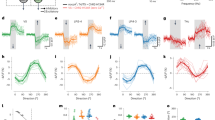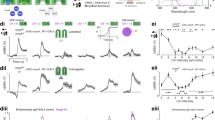Abstract
Motion vision is a major function of all visual systems, yet the underlying neural mechanisms and circuits are still elusive. In the lamina, the first optic neuropile of Drosophila melanogaster, photoreceptor signals split into five parallel pathways, L1–L51. Here we examine how these pathways contribute to visual motion detection by combining genetic block and reconstitution of neural activity in different lamina cell types with whole-cell recordings from downstream motion-sensitive neurons2,3. We find reduced responses to moving gratings if L1 or L2 is blocked; however, reconstitution of photoreceptor input to only L1 or L2 results in wild-type responses. Thus, the first experiment indicates the necessity of both pathways, whereas the second indicates sufficiency of each single pathway. This contradiction can be explained by electrical coupling between L1 and L2, allowing for activation of both pathways even when only one of them receives photoreceptor input. A fundamental difference between the L1 pathway and the L2 pathway is uncovered when blocking L1 or L2 output while presenting moving edges of positive (ON) or negative (OFF) contrast polarity: blocking L1 eliminates the response to moving ON edges, whereas blocking L2 eliminates the response to moving OFF edges. Thus, similar to the segregation of photoreceptor signals in ON and OFF bipolar cell pathways in the vertebrate retina4, photoreceptor signals segregate into ON-L1 and OFF-L2 channels in the lamina of Drosophila.
This is a preview of subscription content, access via your institution
Access options
Subscribe to this journal
Receive 51 print issues and online access
$199.00 per year
only $3.90 per issue
Buy this article
- Purchase on Springer Link
- Instant access to full article PDF
Prices may be subject to local taxes which are calculated during checkout




Similar content being viewed by others
References
Meinertzhagen, I. A. & O’Neil, S. D. Synaptic organization of columnar elements in the lamina of the wild type in Drosophila melanogaster . J. Comp. Neurol. 305, 232–263 (1991)
Joesch, M., Plett, J., Borst, A. & Reiff, D. F. Response properties of motion-sensitive visual interneurons in the lobula plate of Drosophila melanogaster . Curr. Biol. 18, 368–374 (2008)
Schnell, B. et al. Processing of horizontal optic flow in three visual interneurons of the Drosophila brain. J. Neurophysiol. 103, 1646–1657 (2010)
Wässle, H. Parallel processing in the mammalian retina. Nature Rev. Neurosci. 5, 747–757 (2004)
Barlow, H. B., Hill, R. M. & Levick, W. R. Retinal ganglion cells responding selectively to direction and speed of image motion in the rabbit. J. Physiol. (Lond.) 173, 377–407 (1964)
Dubner, R. & Zeki, S. M. Response properties and receptive fields of cells in an anatomically defined region of superior temporal sulcus in monkey. Brain Res. 35, 528–532 (1971)
Borst, A., Haag, J. & Reiff, D. F. Fly motion vision. Annu. Rev. Neurosci. 33, 49–70 (2010)
Strausfeld, N. J. Atlas of an Insect Brain (Springer, 1976)
Hardie, R. C. A histamine-activated chloride channel involved in neurotransmission at a photoreceptor synapse. Nature 339, 704–706 (1989)
Reichardt, W. Autocorrelation, a principle for the evaluation of sensory information by the central nervous system. In Sensory Communication (ed. Rosenblith, W. A.) 303–317 (John Wiley & Sons, 1961)
Rister, J. et al. Dissection of the peripheral motion channel in the visual system of Drosophila melanogaster . Neuron 56, 155–170 (2007)
Katsov, A. Y. & Clandinin, T. R. Motion processing streams in Drosophila are behaviorally specialized. Neuron 59, 322–335 (2008)
Zhu, Y., Nern, A., Zipursky, S. L. & Frye, M. A. Peripheral visual circuits functionally segregate motion and phototaxis behaviors in the fly. Curr. Biol. 19, 613–619 (2009)
Brand, A. H. & Perrimon, N. Targeted gene expression as a means of altering cell fates and generating dominant phenotypes. Development 118, 401–415 (1993)
Luan, H., Peabody, N. C., Vinson, C. R. & White, B. H. Refined spatial manipulation of neuronal function by combinatorial restriction of transgene expression. Neuron 52, 425–436 (2006)
Kitamoto, T. Conditional modification of behavior in Drosophila by targeted expression of a temperature-sensitive shibire allele in defined neurons. J. Neurobiol. 47, 81–92 (2001)
Gengs, C. et al. The target of Drosophila photoreceptor synaptic transmission is a histamine-gated chloride channel encoded by ort (hclA). J. Biol. Chem. 277, 42113–42120 (2002)
Gao, S. et al. The neural substrate of spectral preference in Drosophila . Neuron 60, 328–342 (2008)
Phelan, P., Bacon, J. P., Davies, J. A., Stebbings, L. A. & Todman, M. G. Innexins: a family of invertebrate gap-junction proteins. Trends Genet. 14, 348–349 (1998)
Blagburn, J. M., Alexopoulos, H., Davies, J. A. & Bacon, J. P. Null mutation in shaking-B eliminates electrical, but not chemical, synapses in the Drosophila giant fiber system: a structural study. J. Comp. Neurol. 404, 449–458 (1999)
Haag, J. & Borst, A. Dye-coupling visualizes networks of large-field motion-sensitive neurons in the fly. J. Comp. Physiol. A 191, 445–454 (2005)
Johns, D. C., Marx, R., Mains, R. E., O’Rourke, B. & Marban, E. Inducible genetic suppression of neuronal excitability. J. Neurosci. 19, 1691–1697 (1999)
Laughlin, S. B. & Osorio, D. Mechanism for neural signal enhancement in the blowfly compound eye. J. Exp. Biol. 144, 113–146 (1989)
Reiff, D. F., Plett, J., Mank, M., Griesbeck, O. & Borst, A. Visualizing retinotopic half-wave rectified input to the motion detection circuitry of Drosophila . Nature Neurosci. 13, 973–978 (2010)
Takemura, S. Y., Lu, Z. & Meinertzhagen, I. A. Synaptic circuits of the Drosophila optic lobe: the input terminals to the medulla. J. Comp. Neurol. 509, 493–513 (2008)
Bausenwein, B., Dittrich, A. P. M. & Fischbach, K.-F. The optic lobe of Drosophila melanogaster. II. Sorting of retinotopic pathways in the medulla. Cell Tissue Res. 267, 17–28 (1992)
Bausenwein, B. & Fischbach, K.-F. Activity labeling patterns in the medulla of Drosophila melanogaster caused by motion stimuli. Cell Tissue Res. 270, 25–35 (1992)
Hassenstein, B. & Reichardt, W. Systemtheoretische Analyse der Zeit-, Reihenfolgen- und Vorzeichenauswertung bei der Bewegungsperzeption des Ruesselkaefers Chlorophanus. Z. Naturforsch. B 11b, 513–524 (1956)
Sanes, J. R. & Zipursky, L. Design principles of insect and vertebrate visual systems. Neuron 66, 15–36 (2010)
Fischbach, K. F. & Dittrich, A. P. M. The optic lobe of Drosophila melanogaster. I. A Golgi analysis of wild-type structure. Cell Tissue Res. 258, 441–475 (1989)
Acknowledgements
We thank C.-H. Lee, J. Rister and C. Schnaitmann for providing flies. Shaking B antibody was provided by J. Bacon. We thank W. Essbauer and C. Theile for technical assistance, and R. Schorner for the artwork in Fig. 1a.
Author information
Authors and Affiliations
Contributions
M.J. performed the blocking experiments and neurobiotin injections; B.S. did the rescue experiments; M.J. and B.S. did all fly work and data analysis; S.V.R. analysed expression patterns of the driver lines; D.F.R. and A.B. designed and supervised the study; and A.B. wrote the manuscript with the help of all authors.
Corresponding author
Ethics declarations
Competing interests
The authors declare no competing financial interests.
Supplementary information
Supplementary Figures
The file contains Supplementary Figure 1 and legend. (PDF 160 kb)
Rights and permissions
About this article
Cite this article
Joesch, M., Schnell, B., Raghu, S. et al. ON and OFF pathways in Drosophila motion vision. Nature 468, 300–304 (2010). https://doi.org/10.1038/nature09545
Received:
Accepted:
Published:
Issue Date:
DOI: https://doi.org/10.1038/nature09545
This article is cited by
-
Different spectral sensitivities of ON- and OFF-motion pathways enhance the detection of approaching color objects in Drosophila
Nature Communications (2023)
-
Direction Selectivity of TmY Neurites in Drosophila
Neuroscience Bulletin (2023)
-
A biophysical account of multiplication by a single neuron
Nature (2022)
-
Contrast independent biologically inspired translational optic flow estimation
Biological Cybernetics (2022)
-
A novel setup for simultaneous two-photon functional imaging and precise spectral and spatial visual stimulation in Drosophila
Scientific Reports (2020)
Comments
By submitting a comment you agree to abide by our Terms and Community Guidelines. If you find something abusive or that does not comply with our terms or guidelines please flag it as inappropriate.



